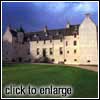|
Around Crieff

Crieff is situated on the southern slope of an impressive
wooded hill, the Knock, on the physical and cultural boundary between the Scottish
Highlands and the Lowlands. Crieff's history includes the town being the administrative
capital of twelfth-century Celtic Earls. It later grew to become one of the most
famous market towns of Scotland where Highlanders drove their cattle from as far
as Caithness and the Outer Hebrides to feed the growing population of the Lowlands.
Many were hanged at Gallowhaugh - now Gallowhill.
The Weaver's House and Highland Tryst Museum in Crieff
shows the development and skills of the Master Weavers of Strathearn and the traditional
tartans for which they became famous.
The Perthshire Highland Golf Ticket can be purchased
at the Crieff Tourist Information Office allowing play on the five participating
9-hole courses throughout a 5 day period and is exceptional value.
Crieff Visitor Centre is a commercial development
just south of the town. Here you will find traditional crafts allied to modern technology
to produce the internationally known Stuart Crystal. The fascinating process of blowing
the molten glass can be watched from the viewing gallery.
Across the road is the Crieff Plant Centre, Buchan
Pottery and Perthshire Paperweights with a myriad of potential gifts. There is also
a modern self-service restaurant, which serves a variety of good dishes.
Innerpeffray Library, 4 miles (6km) south-east of
Crieff, is a must for book-worms or anyone interested in Scotland's oldest surviving
free-lending library which houses 3,000 titles printed between 1502 and 1800.
 Drummond Castle, 2 miles (3km) south of Crieff, was originally
built around 1490 but destroyed intentionally in 1745 by its owner, the Duchess of
Perth, to prevent its falling into the hands of Cromwell's troops. It was then rebuilt
in Tudor style and includes a magnificent Italian formal garden. Drummond Castle, 2 miles (3km) south of Crieff, was originally
built around 1490 but destroyed intentionally in 1745 by its owner, the Duchess of
Perth, to prevent its falling into the hands of Cromwell's troops. It was then rebuilt
in Tudor style and includes a magnificent Italian formal garden.
Muthill is another conservation village 3 miles (5km)
south of Crieff on the A822. It is largely unspoilt with late eighteenth-and early
nineteenth-century housing and architecture. The church at the village's centre was
once an important fifteenth-century focus of worship with an earlier twelfth century
Norman tower.
Continuing south on the A823 brings you to Auchterarder,
a long Strathearn town with a fairly rich historical past and most of its older buildings
hugging the High Street. The town became chief burgh of the important earldom of
Strathearn shortly after the turn of the eleventh century.
During an early Jacobite rising in 1715 the town was
destroyed by the retreating Earl of Mar. The tower in the old churchyard is the only
remnant of the town's turbulent past. In rooms above the tourist office, a heritage
display illustrates the regions past.
The sumptuous Gleneagles Hotel, golf courses and leisure
complex sits above a scenic wooded and moorland glen surrounded by the Ochil Hills
with Glen Devon to the south. Contrary to its inference, the name, Gleneagles, is
not associated with that majestic bird of prey but is Gaelic for'glen of the church'.
Ardoch Roman Camp, 10 miles (16km) south of Crieff
near Braco on the A822, dates back to the second century. This was one of the largest
Roman encampments of ancient Britain.
 To the west of Crieff about 1 mile (2km) on the A85 is Scotland's
oldest Malt Scotch Whisky distillery. Established in 1755 alongside the Shaggie Burn,
the Glenturret Distillery offers guided tours around the stills. It also has an award
winning visitor's heritage centre. The distillery also offers two good restaurants,
the Smuggler's and the Pagoda Room, a gift and whisky shop with, of course, a whisky-tasting
bar. To the west of Crieff about 1 mile (2km) on the A85 is Scotland's
oldest Malt Scotch Whisky distillery. Established in 1755 alongside the Shaggie Burn,
the Glenturret Distillery offers guided tours around the stills. It also has an award
winning visitor's heritage centre. The distillery also offers two good restaurants,
the Smuggler's and the Pagoda Room, a gift and whisky shop with, of course, a whisky-tasting
bar.
Comrie's claim to fame might be that it sits directly
on the Highland Boundary fault and experiences regular earth tremors of no great
consequence. Earthquake House, built in 1874, situated just outside Comrie at the
Ross, contains a replica of the first seismometers set up here in the Victorian era.
There is a good healthy eatery just past the Ross Bridge on the west side of town,
Tullybannocher Farm Food Bar and Restaurant alongside several craft shops and a nursery.
At midnight on Hogmanay in Comrie, a unique Flambeaux
Procession takes place, a torchlight parade through the streets to drive out the
evil spirits for the coming year, followed by the usual Scottish exuberance for this
particular holiday period.
Just north of Comrie is the Deil's Cauldron which
is a grand waterfall carrying the River Lednock down to meet the River Earn.
Two miles (3km) south of town on the B827 is the Auchingarrich
Wildlife Centre which holds the largest bird collection in Scotland in its 100 acres
(40hectares). There are 17 ponds with 100 species of water-fowl and a wild bird hatchery
where you can watch newly hatched chicks. Wallabies, Highland cattle and deer occupy
the larger enclosures. Afterwards there is the welcoming Pine Lodge restaurant. Another
good stop in these parts, especially if you have children, is Drummond Trout Farm
and Fishery. There are several ponds to cater for every angler, no matter how inexperienced.
|



